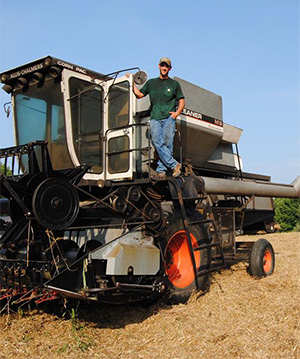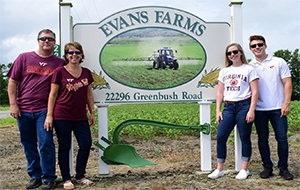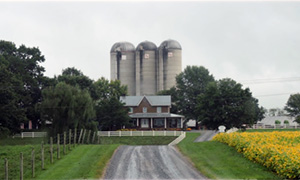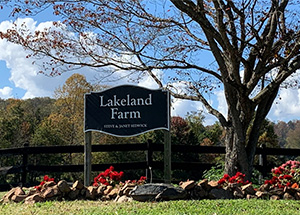
 Department of Conservation and Recreation
Department of Conservation and Recreation
Conserve. Protect. Enjoy.
 Department of Conservation and Recreation
Department of Conservation and Recreation
The annual Virginia Clean Water Farm Awards recognize farmers who implement conservation practices and do their part to preserve water quality. The program is sponsored by the Virginia Department of Conservation and Recreation in partnership with Virginia’s 47 Soil and Water Conservation Districts. Grand Basin winners represent the most exceptional of these awardees. One winner is selected from each of Virginia’s 10 river drainage basins. The winners’ conservation practices and dedication to protecting natural resources make them role models for producers across the state. We hope you enjoy reading about these exemplary farms and the people who own and manage them. Many thanks to district staff members who made this another outstanding year for the Clean Water Farm Awards.

Big Sandy - Tennessee River Basin
Steve and Charlie Smith, Holston Vista Farm
Nominated by Holston River Soil and Water Conservation District
Steve and Charlie Smith own and run Holston Vista Farm, a 550-acre, seventh-generation family livestock and crop operation in Washington County. For the last quarter century, the brothers have helped protect water quality by participating in multiple conservation programs. Their livestock are excluded from 100% of the farm’s surface water, which includes more than a mile of the Middle Fork of the Holston River and several thousand feet of tributaries that flow into the river. More than 10 acres of buffer reinforce these exclusions. Pastureland is divided into several paddocks — each with centrally located watering troughs — to foster better grazing distribution. After installing alternative watering systems in the late 1990s, the Smiths promoted the benefits of rotational grazing by becoming contractors installing watering systems for other farmers in the county. Their conservation efforts extend to their cropland, which follows a conservation plan and is rotated regularly. Cover crops follow all row crops. In addition, livestock manure is collected and applied as fertilizer, in accordance with a nutrient management plan.

Chowan River
John Shepherd, Shepherd Grain Farms
Nominated by Piedmont Soil and Water Conservation District
In just 14 years, John Shepherd has taken Shepherd Grain Farms from 25 to 3,100 acres. Nevertheless, Shepherd’s proudest accomplishment is using conservation best practices to transform once-eroded, degraded soil into rich, fertile farmland. Planting cover crops, adhering to continuous no-tillage practices and applying alternative fertilizers such as poultry litter on his farm have delivered highly productive soils with minimal costs. He monitors and continuously improves his land and crops through soil testing, grid sampling and precision-applied nutrients. In fact, the soils Shepherd manages have become so productive that he won a state yield contest in 2015 for producing a substantial soybean crop for the lowest cost per bushel. But he hasn’t stopped there. Shepherd is also enrolled in DCR’s Resource Management Plan program to bring in additional best practices that will reduce water runoff and erosion. Plans for grassed waterways, critical area plantings and buffers are underway. He is also working to replant pine and hardwood trees across his forestland. To provide wildlife habitat, Shepherd is planting pollinator and wildlife food plots and creating cover and nesting habitat by leaving dead trees and building brush piles.

Coastal
Jim Evans, Evans Farms
Nominated by Eastern Shore Soil and Water Conservation District
Accomack County native Jim Evans farmed evenings and weekends throughout a 20-year teaching career before building a large crop operation across land that had been farmed by three generations of his family. He primarily grows corn and soybeans on his 4,000-acre farm, and has partnered with another local producer to farm an additional 700 acres. His regimen of wheat and barley cover crops, along with minimal tillage, boosts soil health and reduces loss by maintaining the soil’s organic matter and biological activity. Evans maintains a nutrient management plan and uses precision, variable-rate nitrogen application equipment and low-drift spray nozzles to most effectively fertilize his cropland and curb runoff. He has also planted 2 acres of pollinator habitat to attract local insects and enrich the ecosystem for other wildlife. An advocate of agricultural conservation, Evans is devoted to improving the quality of his local farming environment for future generations. His daughter, Claire, is now following in his footsteps as she acquires the conservation farming skills that have made her father so successful.

James River
The Teel Family, Clover Green Farm LLC
Nominated by Thomas Jefferson Soil and Water Conservation District
Clover Green Farm has been in the Teel Family since the late 1700s. Today, it features 190 acres of mixed pasture, 20 acres of vineyard and 130 acres of woodlands. The Teels run 52 registered Hereford brood cows through an intensive rotational grazing system that maximizes grazing efficiency and productivity. Using permanent infrastructure, portable fencing and quick connects, they move the herd to new grass each day in a grazing rotation that typically allows at least 45 days’ rest for each paddock. This rotation system has increased grass productivity and generated fescue stockpiles for winter grazing. It also reduced the required number of hay bales to just 30 last winter — down from almost 250 bales per year in generations past. In September, the Teels began overseeding some of their pastures with a rich variety of vegetation to improve organic matter, break up compaction and foster rich soils. More than 30 acres of riparian buffer developed in the last few years have protected 21,000 feet — almost 4 miles — of streambanks and invited wildlife back to the farm. Now deer, turkey and bear are abundant, and quail that had not been seen in years have been spotted on the farm in the last year.

New-Yadkin River
The Hudgins Family, DRH Farm
Nominated by Big Walker Soil and Water Conservation District
Mason Hudgins and his family own and operate a 440-acre beef cattle and crop farm and manage 52 acres of pine and hardwood timber. Knowing the impacts livestock had on the farm’s live waters — including Reed Creek, the water source for the town of Wytheville — the Hudgins family used multiple programs to fence more than 25,000 feet of creeks and tributaries and create 11.5 acres of new riparian buffer. A rotational grazing system is used on all grazing lands, and they have installed 20,000 feet of cross fence, two livestock stream crossings, hundreds of feet of trails and walkways and 20 alternative watering systems. The land is cultivated using a 100% no-till program and nutrient management plan. Fall applications of phosphorus and pot-ash increase root growth for winter months, and clover is frost seeded to provide alternative nitrogen productivity. Their most recent project is the design and layout of a winter feeding area for backgrounded cattle. By installing hardened feeding areas accessible from the grazing paddocks, but away from all waters, and ensuring good buffer in all downslope drainages, they will mitigate soil degradation and nutrient runoff associated with bunk feeding.

Potomac River
Karla Evans, Creek Hill Farm
Nominated by Loudoun Soil and Water Conservation District
Karla Evans manages her 213-acre Creek Hill Farm in Loudoun County to ensure water quality will be protected for future generations. Through rotational management of her pastures, she has also improved the soil for her grass-fed Scottish Highland beef cattle, applying nutrients as soil tests recommend and managing weeds through an integrated pest management strategy that prioritizes grazing over herbicides. Most importantly, by installing nearly 10,000 feet of fencing, Evans has protected 106 acres of forested riparian buffer and eliminated livestock access to all streams on the property. Not only does this recharge groundwater and improve water quality, habitat for wildlife has improved for numerous species of plants and animals as a result. Evans’ forward thinking extends to her educational outreach, as she has hosted riparian planting workshops for students from Monroe Technology Center, The Hill School and Foxcroft School. And because she oversees four other family parcels comprising an additional 816 acres, Evans is collectively supporting the sustainability of the Evans family farms and contributing significantly to improving water quality of the Potomac River and Chesapeake Bay by extending her best practices to the additional acreage.

Rappahannock River
Jacob & Jennifer Gilley, Heaven’s Hollow Farm
Nominated by Culpeper Soil and Water Conservation District
Young farmers Jennifer and Jacob Gilley – who met through 4-H – steward Heaven’s Hollow Farm, 200 acres on the border of Madison and Orange counties. The couple proudly model a sustainable lifestyle for their three young children, and enjoy sharing their story with the customers they welcome to Heaven’s Hollow for beef, pork, chicken and eggs. A highlight of their operation has been the creation of 14.6 acres of riparian buffer along Beautiful Run and its tributaries by installing 9,800 feet of livestock exclusion fence. Prior to the stream fencing projects, the farm had a total of seven fields for the livestock to graze, but now the farm rotates its cattle through 13 fields, improving the pasture quality significantly. And their 35-foot-wide buffers have enhanced habitat for grassland birds, pollinators and other wildlife.

Roanoke River
Brian Hall, IJN LLC
Nominated by Halifax Soil and Water Conservation District
Award-winning farmer Brian Hall operates a 150-cow-and-calf herd on more than 300 acres of pasture. He was previously recognized as 2018 Cooperator of the Year and local CWFA winner in 2019. A longtime participant in best management practices, Hall most recently has been working with Virginia Cooperative Extension testing soybean plots on his farm. He grows full-season soybeans and double-crop soybeans and wheat, and plans to add corn in his rotation next year. Planting cover crops is a consistent practice for Hall, who puts in as much as possible on over 1,000 acres of cropland each season. He recently began aerial seeding his cover crops in order to stabilize the soil faster and trap and mine nutrients longer. Hall also participates in the chicken-litter transport program and uses litter on cropland and pastures. All of his cattle are excluded from streams and ponds, with more than 65,000 feet of exclusion fence creating forested buffers. Hall follows a nutrient management plan, conservation plan and a prescribed grazing plan that includes rotational grazing, strip grazing and grazing a portion of his cover crops.

Shenandoah River
Weldon Heatwole, Cedar Ridge Dairy, Inc.
Nominated by Shenandoah Valley Soil and Water Conservation District
Weldon and James Heatwole’s Cedar Ridge Dairy maintains a herd of 135 milk cows, 20 dry cows and 175 heifers. Cedar Ridge regularly earns the Virginia’s Finest designation for producers who meet strict milk quality standards, a testament to their exceptional management. The tradition of stewardship extends across the family, and Weldon’s other sons have been recognized with Clean Water Farm Awards. All of the Heatwoles continue to incorporate new technology into their operations to be more efficient, productive and environmentally friendly. The Cedar Ridge Dairy milking herd is managed in freestalls that are bedded using soybean stubble that has been chopped and stored. Cattle are fed a mixed ration and hay at bunks but are also rotated through 40 acres of pasture to graze. An additional 340 acres of cropland is managed in rotation and monitored for nutrients and pests. Because the Heatwoles believe in maximizing soil health and the nutrient content of manure, they use an additive that helps break down solids, reduce ammonia and encapsulate nitrogen, ultimately helping to maximize its value. And, as a gift to farmers and non-farmers alike, the Heatwoles have dedicated a 4-acre recreational area by the Shenandoah River to public access.

York River
The Sedwick Family, Lakeland Farm
Nominated by Culpeper Soil and Water Conservation District
The Sedwick family’s 770-acre Lakeland Farm includes pasture, hay and managed forest for wildlife and timber production. The farm has evolved from a continuous grazing system to an intensive, rotational grazing system that uses its forages to produce pounds of beef while protecting water quality through established buffers. Generations of Sedwicks have worked together to protect the water quality of Tomahawk Creek and Poorhouse Run, which drain into Pamunkey Creek and on to the North Anna River. The farm’s brood-cow herd consists of 130 head of mostly Angus cattle that are grass fed and supplemented with hay as needed. Lakeland Farm focuses on cool season grass production, moving the cattle weekly depending on forage availability and season. In addition to concern for their soil, the family is also conscious of their water resources, and have fenced cattle from all streams. Most of the farm drains to Poorhouse Run, where hardened stream crossings were installed through the cost-share program, and the cattle drink from 17 permanent watering troughs in the pastures. Thanks to their thoughtful management, the Sedwicks have noticed improved herd health, better weight gain on the calves and increased milk production.

